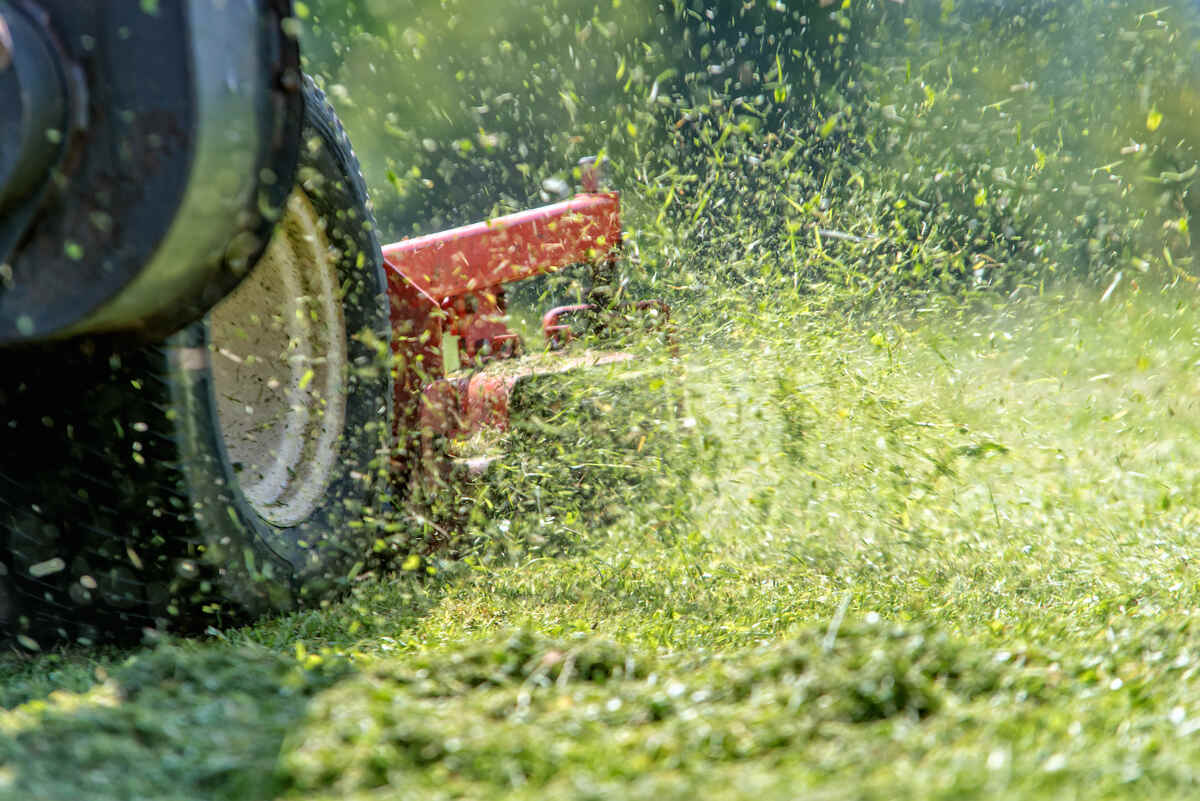
You may have wondered about the best way to deal with grass clippings. Mulching and side discharge are both popular options that return clippings to your lawn.
However, homeowners and pros alike prefer one over the other for different reasons. In the battle of mulching vs. side discharge, which comes out on top?
We’ll tell you right now: It all depends on what you want out of your grass clippings, how much time you have, and how much effort you’re willing to put into mowing. Let’s take a look at the differences between mulching and side discharge so you can figure out which method of handling lawn trimmings suits you best.
What is Mulching and Why Should I Do It?
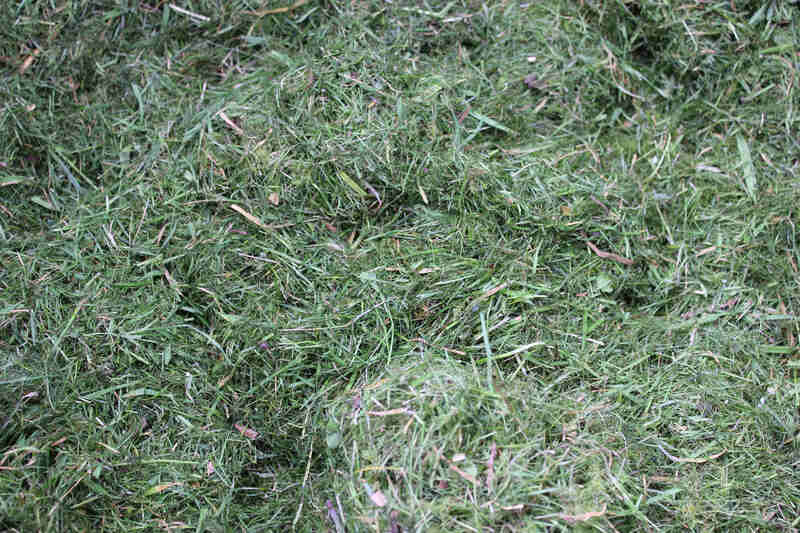
A mulching mower (or mulching attachment) chops up your grass clippings into tiny pieces to help them decompose faster on your lawn. The small pieces of grass (mulch) fall onto your lawn as you mow. Mulching lawn mowers have closed decks, while converted mowers have chute covers that keep the grass inside the mower deck until they’ve been chopped up.
This table details the pros and cons of mulching your grass clippings:
| Mulching Pros | Mulching Cons |
| ✓ Returns nutrients to your lawn ✓ Faster than bagging ✓ Clippings look cleaner when mulched compared to side discharge ✓ Safer than side discharge | ✗ Not ideal for tall or wet grass ✗ Need to clean mower more often ✗ Tall grass strains the mower ✗ Slower than side discharge ✗ Doesn’t cut as cleanly as side discharge |
Let’s go over these points in detail.
Pros of Mulching Lawn Clippings
✓ Returns nutrients to your lawn: The main benefit of mulching grass clippings is that you’re returning nutrients to your lawn every time you mow. The experts at Michigan State University Extension say that returning grass clippings to your lawn (a process also known as grasscycling) can cut down on fertilizer use by as much as 1 pound per 1,000 square feet every year. That’s a lot of free nutrients!
✓ Faster than bagging: Another reason to mulch your lawn clippings is to cut down on mowing time. It’s not the fastest way to deal with grass clippings while you mow, but it’s faster than emptying or replacing your grass catcher bag when you bag your clippings.
✓ More aesthetically pleasing: If you need to leave clippings on your lawn, mulching them is the better option in terms of aesthetics — at least, when it comes to the clippings themselves. Smaller clippings blend into the lawn and don’t sit on top of the grass, so your lawn looks cleaner than if you side discharge.
✓ Safer than side discharge: Lastly, mulching your lawn clippings is safer than side discharge. While mowing, any rocks and debris can get under the mower deck. With side discharge, this debris can get flung out at high speeds. The closed mower deck required to mulch lawn clippings makes this less likely to happen.
See Related: How to Improve Your Lawn With Mulch
Cons of Mulching Lawn Clippings
✗ Can’t mow wet or tall grass: You can’t mow and mulch clippings if your grass is wet or too tall. Mowing your grass while wet is already bad (read why here: Why Mowing a Lawn When Wet Is (Usually) Bad), but using a mulching mower on wet grass will make it clump up. At best, the mower will spit out clumps of wet grass; at worst it will clog the mower.
✗ Need frequent cleaning: Mulching mowers are more prone to building up gunk underneath the mower deck, so they need to be cleaned more often. This is especially true if you’re trying to mow wet grass and tall turf.
✗ Tall grass strains the mower: Mowing tall grass with the intention of mulching puts strain on the mower. The lawn mower has to work harder to chop up longer pieces of grass, and as a side effect, it’ll also take you even longer to mow your lawn. Tall grass mowed with mulching blades also won’t be cut cleanly.
✗ Mulching is slower than side discharge: Compared to side discharge, mulching is slower. You have to give the mower time to cut up the grass clippings and drop them onto your lawn. If you go too fast, you may end up with an uneven spread of grass clippings on your lawn.
What is Side Discharge and Why Should I Do It?
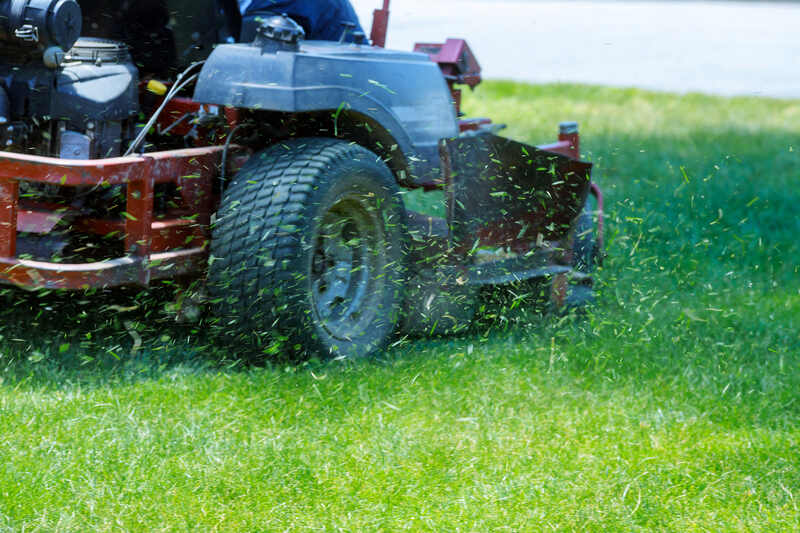
A lawn mower with side discharge takes the grass clippings and expels them out a side port or chute as you cut your grass. Usually, these grass clippings are ejected several feet away.
This table shows the pros and cons of side discharge:
| Side Discharge Pros | Side Discharge Cons |
| ✓ Faster mowing times ✓ Good-quality, clean cut even on tall and wet grass ✓ Even distribution of grass clippings ✓ Stripes better than mulching | ✗ Can shoot clippings into unwanted places ✗ More likely to shoot debris ✗ Grass clippings look messier and won’t decompose as fast |
Now, let’s dive deeper into these bullet points.
Side Discharge Pros
✓ Faster mowing time: The most compelling reason to switch to side discharge is just how fast it is compared to both mulching and bagging. You don’t have to worry about bagging or distributing your mulched lawn clippings evenly, as everything is spewed out of the mower. All you need to do is mow.
✓ Provides a nice, clean cut: Next, side discharge results in a cleaner cut, even if your grass is tall and overgrown or after a rain shower. The force required to expel the grass clippings is strong enough to dislodge wet and long lawn clippings. The cleaner cut of a side discharge mower is also better for lawn stripes, if you like that look. (And if you do, we have a guide on How to Add Stripes to Your Lawn Like a Pro.)
✓ Even distribution of grass clippings: Lastly, side discharge distributes the grass clippings more evenly as long as you keep mowing at a steady pace. You might need to take a rake to your clippings once in a blue moon, though. Otherwise, the clumps of grass might choke your lawn, resulting in brown spots.
Side Discharge Cons
✗ Shoots clippings everywhere: The number one disadvantage of side discharge is how the grass clippings can get into places they shouldn’t be: flower beds, walls, driveways, streets, and even your neighbor’s yard. At best, this leads to a mess; at worst, you may be flinging weed seeds into your landscaping and your neighbor’s lawn.
There are ways to prevent — or at least control — the discharge:
- Operator-controlled discharge chutes (OCDC) offer a way for homeowners to stop the mower from ejecting grass clippings for a short period.
- Chute blocks or block-off plates are used to block the side discharge temporarily. Some can be opened at an angle to allow side discharging closer to the mower.
- Simply changing the direction of your mower will prevent grass clippings from getting spewed onto unwanted spaces.
Note: Some areas will fine you (usually for littering) if you leave lawn trimmings on the street or the road. Lawn clippings can also be dangerous to motorcyclists when left on the road (read why here: Lawn Clippings Can Pose Deadly Danger to Motorcyclists).
So, if you don’t want to get in trouble with your neighbors (or worse, the authorities), make sure to blow grass clippings back onto your lawn if they’re discharged outside of your property.
✗ Shoots rocks and dangerous debris: Grass clippings aren’t the only thing that can come flying out of a side discharge chute. Side discharge can also chuck out rocks and other debris several feet away at fast speeds. It’s not much of a problem if you hit a wall, but it can injure others if the debris hits them. As a safety measure, close the lawn to pets and people (especially children) while you mow.
✗ Makes your lawn look messier: Lastly, grass clippings stand out on your lawn more. They might even stay on top of the grass instead of filtering down to the soil. Aside from being less pleasing aesthetically, these longer clippings also break down less quickly and return nutrients slower than those that were mulched. They may not even decompose if they don’t reach the soil.
Is Mulching Better Than Side Discharge?
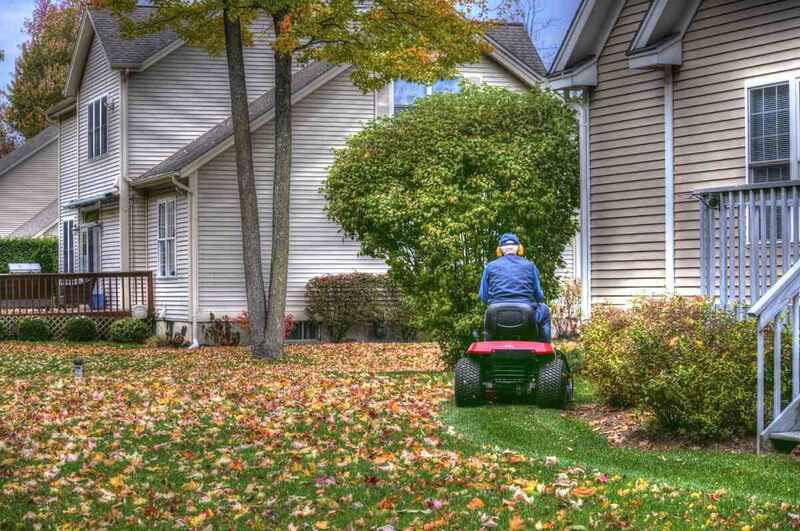
As we said earlier, it all depends on you — your wants, time, and willingness to put in effort — that determines whether mulching or side discharge is better for you.
If you and your lawn have the following attributes, you may find that side discharge will be the more attractive choice:
- Large yard space. If you have a large yard, the speed and ease of side discharging will ensure you don’t spend your whole afternoon mowing. A large lawn also means you’re less likely to get your grass clippings in places they shouldn’t be.
- Overgrown grass. Whether you like to go a longer time in between mowings or if you’ve accidentally let your lawn grow out too much, side discharge will be better for you. However, we do recommend following the one-third rule (cutting off only 1/3 of your grass’s total height at a time) if you can. Learn more here: One-Third Rule.
- Wet turf. If it rains a lot in your area, you may be better off with side discharge, as your lawn will almost always be wet. You can also opt for side discharge if you can’t wait for your lawn to dry off.
- Little time. If you’re someone who doesn’t have a lot of time to spare, side discharge will probably work best for you, as it’s the fastest way to deal with lawn trimmings. Side discharge also works best for homeowners who can only mow their lawns every two weeks, especially during your turf’s peak growing season.
On the other hand, mulching your lawn clippings might be the better option for you if you and your lawn have these qualities:
- Small yard space. Mulching is better for smaller yards, as it’s not likely to spray grass clippings onto your walls, landscape beds, driveway, or neighboring property.
- Frequent mowing schedule. Since the grass is less likely to be tall and overgrown when you mow weekly (or even more frequently), mulching mowers have less difficulty chopping up the lawn clippings.
- Conscious about turf health. Your lawn will benefit a lot from the free nutrients returned from decomposing clippings. Opting to mulch your lawn also means committing to mowing your lawn more frequently, which means you’re more likely to follow the one-third rule.
- More free time. You don’t have much to lose except for time if you opt to mulch your clippings. You get a neater lawn and free fertilizer; what’s not to love?
Most of the time, you won’t have to buy a whole new mower just to convert from mulching to side discharge or vice versa. Many modern lawn mowers offer both (some also offer bagging), either built-in or sold separately as attachments. But if you are in the market for a new lawn mower that can do it all, you can take a look at our best lawn mower reviews for some ideas:
- Best Lawn Mowers
- Best Mulching Lawn Mowers
- Best Lawn Mowers for Big Yards
- Best Lawn Mowers for Small Yards
FAQs About Mulching vs. Side Discharge
You may have heard that leaving grass clippings on your lawn contributes to excessive thatch buildup. Thatch is the layer of living and dead organic material that accumulates between your grass and the soil’s surface. Being made out of grass leaves, lawn clippings should contribute to thatch, right? It sounds like a reasonable assumption.
However, that simply isn’t true. It was — and still is — a common belief, but grass clippings don’t contribute to lawn thatch buildup. Many experts, including those at the University of Minnesota Extension, say that lawn clippings break down too fast to significantly affect thatch production.
See Related: What is Thatch in Your Lawn?
Sometimes, leaving grass clippings on your lawn isn’t the ideal choice. You might not want to leave grass on your lawn if:
• Your turf is diseased. Grass trimmings can spread diseases. Make sure to deal with lawn diseases as soon as you can (or hire a lawn treatment professional to do it for you). Learn how to treat common lawn diseases with our article here: Common Lawn Diseases and How to Identify Them.
• There’s too much of it. Like all things, an excessive amount of grass clippings left on the lawn can smother your turf and lead to brown spots. Usually, this becomes an issue if you aren’t keeping on top of your lawn mowing duties.
• Your lawn is newly seeded. The new grass is too delicate to handle the weight of the trimmings.
• Your lawn needs dethatching. And it’s not because the clippings will add to the thatch. The clippings can’t decompose if the thatch layer is too thick because it can’t reach the soil microorganisms that break them down, says the University of Missouri Extension Service.
• Your lawn is overrun with weeds. You might cut weed seed heads, which can make your weed problem worse.
• You have children or pets. They might eat the grass, which isn’t too bad unless they’re not yet dried or if they have been sprayed with lawn treatments. (You can read more about that here: Grass Clippings Can Sicken Horses, Pets, Livestock.) Also, they might track the clippings indoors after playing in your yard, which makes a mess.
• Add them to your compost pile. Grass clippings make an excellent “green” waste material that adds nitrogen to your compost pile. Read our guide to composting to learn more. Note: Don’t compost grass clippings from grass that has been recently treated with herbicides. Don’t compost if you have a lot of weeds either.
Your local community may also offer curbside composting, so you won’t have to worry about composting them yourself.
• Use them as mulch elsewhere in your garden. Grass clippings are a source of free mulch. Just make sure they’re dry before using them as mulch.
• Bag and dispose. If your lawn has too many weeds, then just bag your clippings and dispose of them.
However, not all states allow you to throw away your grass clippings in the trash. According to the US Composting Council, the following states limit or ban the disposal of yard clippings:
• Arkansas
• Delaware
• Florida (only allowed in landfills with gas collection systems)
• Georgia (only allowed in landfills with gas collection systems)
• Illinois
• Indiana
• Iowa (only allowed in landfills with gas collection systems)
• Maryland
• Michigan
• Minnesota
• Missouri
• Nebraska (only allowed in landfills with gas collection systems)
• New Hampshire
• North Carolina
• Ohio
• Pennsylvania
• Rhode Island
• South Carolina
• South Dakota
• West Virginia
• Wisconsin
Note: Your local county or municipal authorities also may have banned grass clippings from being thrown in the trash, even if they aren’t banned statewide.
Hire a Lawn Care Pro for a Clean Cut
Mulching and side discharge both have their strengths and weaknesses. One of their main differences is the amount of time it takes to complete a mowing session. Side discharge is fast, while mulching is slower (but more helpful to your lawn). But what if you don’t have time to mow your lawn at all?
Leave it to LawnStarter’s lawn maintenance pros. We will connect you with a capable local lawn care pro from our network of professionals. They’ll come in weekly — or whenever you want — to give your lawn a clean cut, and they can handle weeding, fertilizing, and more, too. All it takes is a few clicks to get your free quote.
Main Image Credit: danimages / Adobe Stock
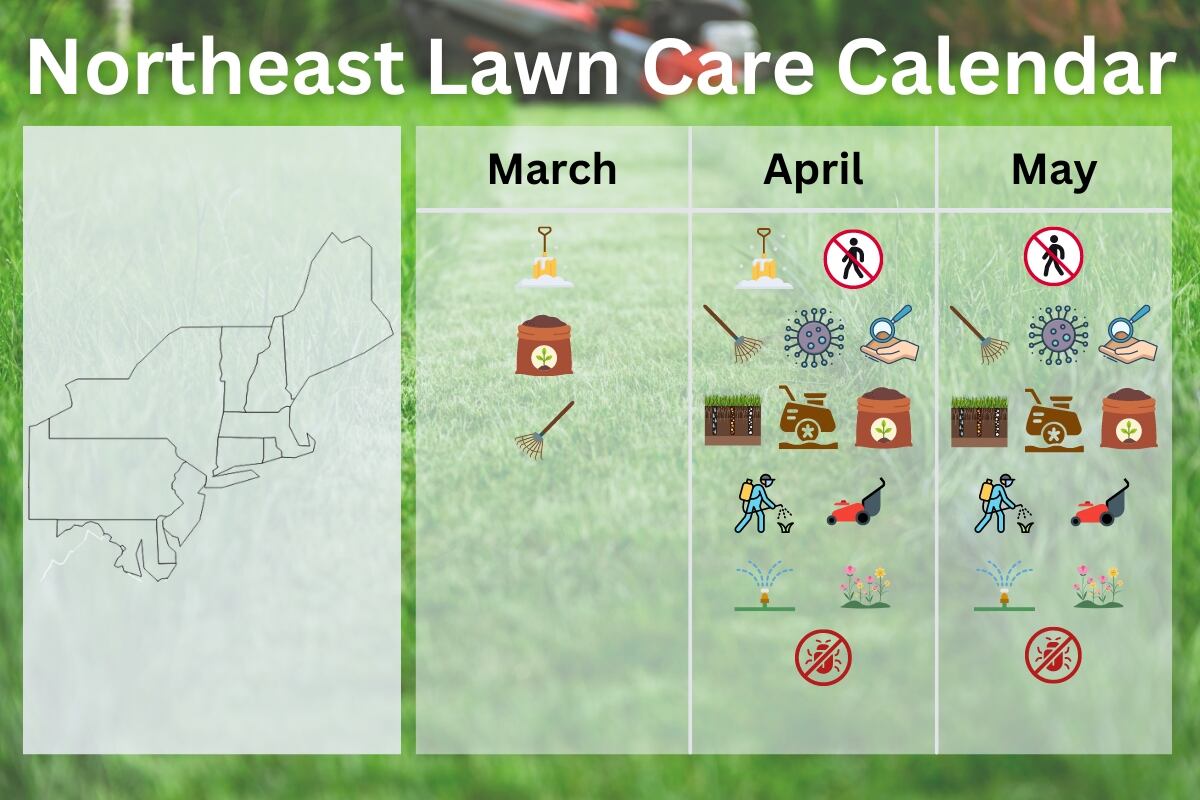
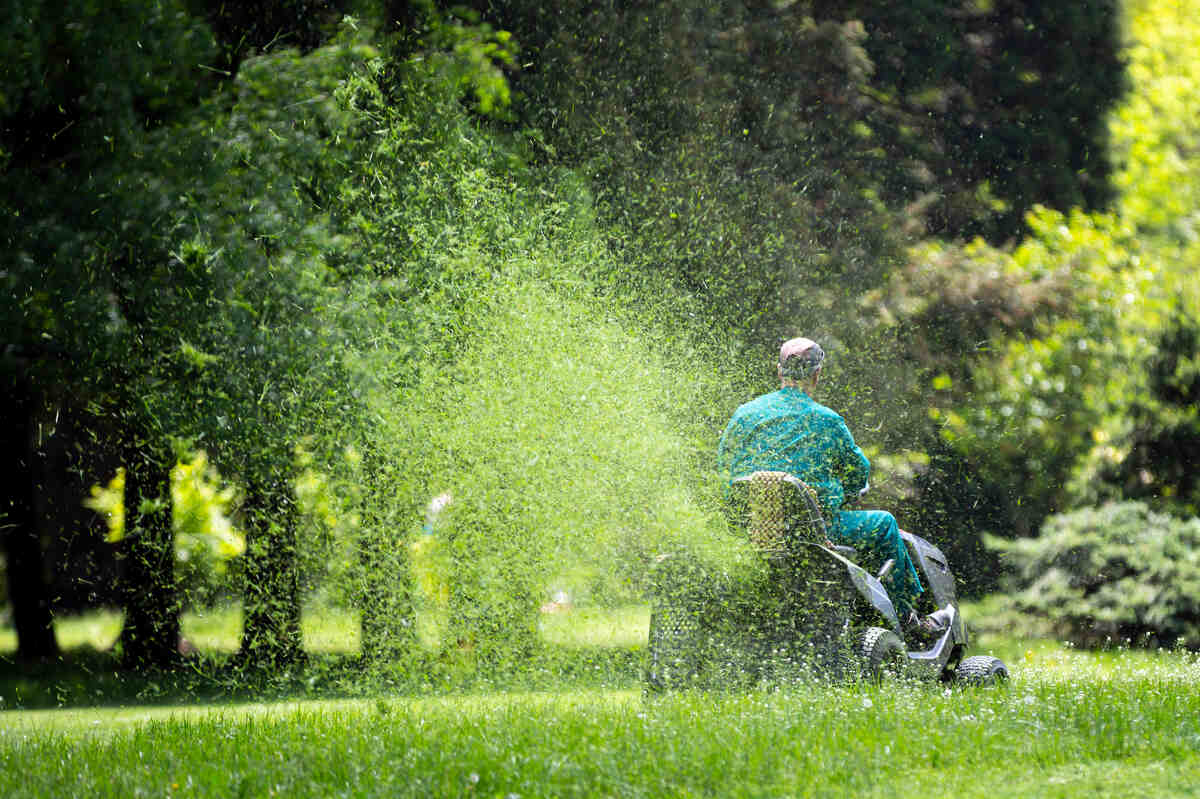
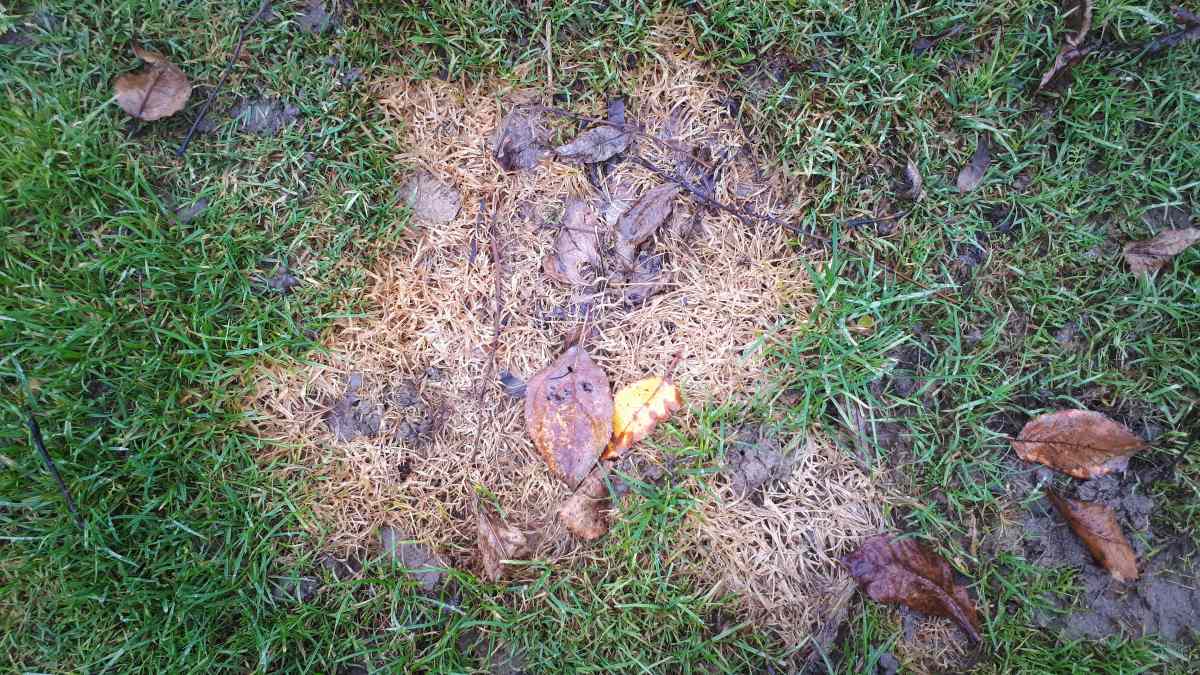

![7 Best Gas Lawn Mowers of 2025 [Reviews] person usiing lawn mower with text overlay on it](https://www.lawnstarter.com/blog/wp-content/uploads/2021/07/Best-Gas-Lawn-Mowers.jpg)